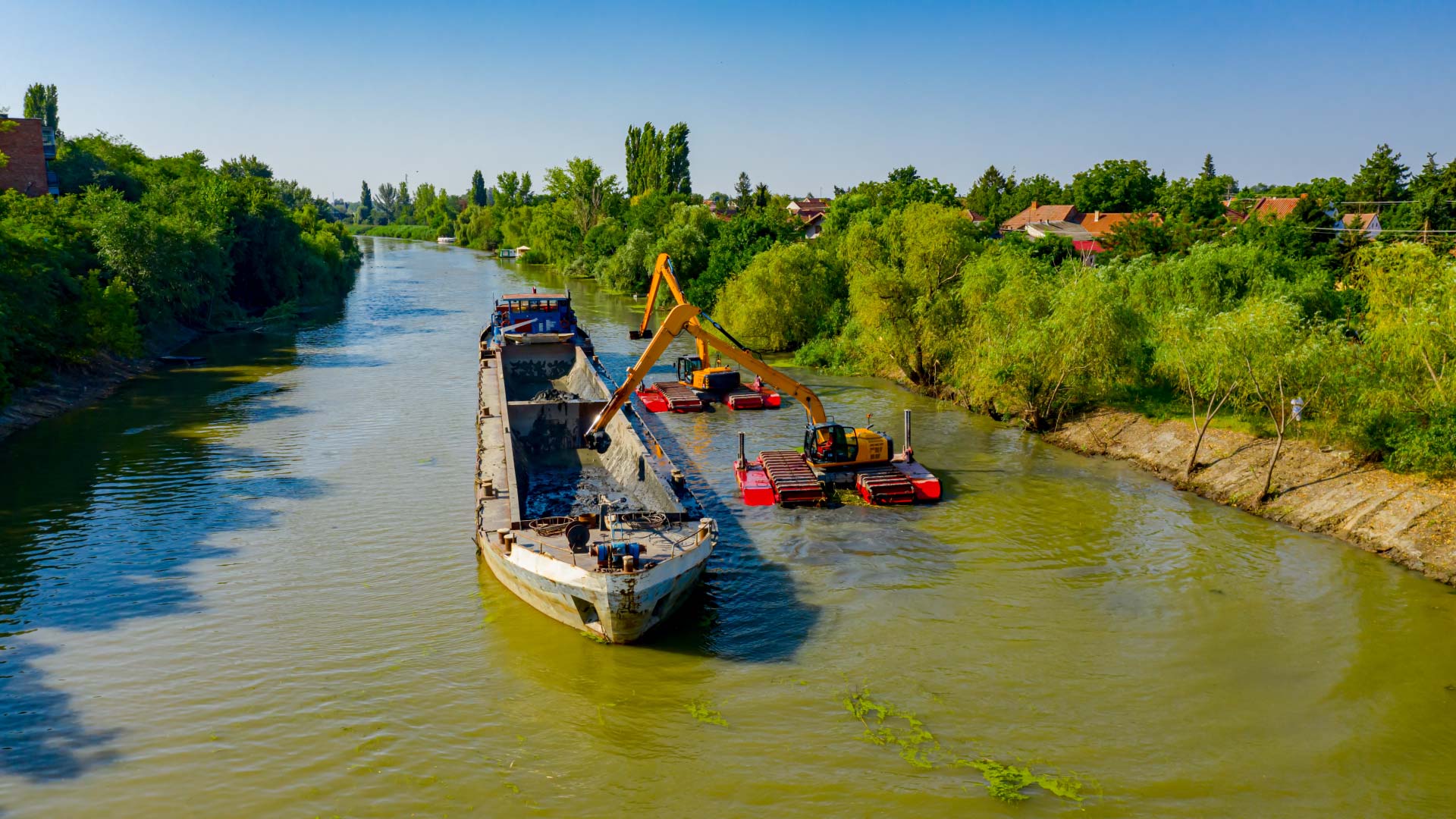What is Dredging and Why is it Necessary?
Dredging is an essential operation for maintaining waterways, ports, and marinas, ensuring they remain navigable and safe for vessels. Dredging removes sediment buildup that can restrict navigation, affect water quality, and limit the functionality of these areas. By using specialized equipment, dredging operations are able to achieve high levels of precision and efficiency. This guide introduces students to some of the key dredging equipment, specifically the swinging ladder dredge and long-reach excavator on a barge, and explores their unique functions in sediment removal.
Dredging is the process of removing accumulated sediment and debris from the bottom of bodies of water like rivers, lakes, and marinas. Over time, natural processes such as sediment runoff, tides, and currents cause sediment to settle and build up, which can obstruct navigation and disrupt aquatic ecosystems. Dredging restores the original depth and width of channels and marinas, facilitating better water flow and improved access for vessels.
Dredging also offers both environmental and economic benefits. By deepening channels and maintaining navigable waterways, dredging allows for smoother transport of goods, supporting trade and local economies. Environmentally, it can help manage water quality, prevent flooding, and enhance the health of aquatic ecosystems by removing contaminated sediments.
Key Equipment in Dredging Operations
Swinging Ladder Dredge
The swinging ladder dredge is a unique and highly effective tool for dredging in narrow or winding channels. It’s particularly valuable in areas where space is limited, as the ladder’s swinging motion allows it to remove sediment in tight spots.
A key feature of the swinging ladder dredge is its ability to pivot the ladder from side to side, effectively sweeping across the channel to remove sediment with precision. The swinging motion allows operators to control sediment removal, making it an ideal choice for working within confined spaces or around bends in a channel. The swinging ladder dredge’s confined area compatibility and precision make it a vital asset in dredging operations focused on accuracy, especially in sensitive environmental areas where minimizing disruption is essential.
Long-Reach Excavator on a Barge
The long-reach excavator, mounted on a barge, is another specialized piece of equipment designed for dredging operations. Its primary purpose is to access confined spaces within marinas and other areas where traditional dredgers may struggle to reach. By being mounted on a barge, the long-reach excavator has the stability and mobility necessary to operate effectively on water.
This excavator’s extended reach allows it to dredge in hard-to-access locations, such as boat slips in marinas. This extended reach is critical in situations where dredging must be conducted without disturbing other parts of the marina or harbor. The educational takeaway here is the concept of “reach” in dredging operations. The long-reach excavator demonstrates how specialized equipment is adapted to specific dredging challenges, such as confined space dredging, making it effective in precise sediment removal.
Techniques and Methods of Sediment Removal
Various techniques are used in dredging, including hydraulic and mechanical methods, each suitable for different types of sediment and environmental conditions.
- Hydraulic Dredging uses water pressure to transport sediment through a pipeline. This technique is efficient for softer sediments and large volumes.
- Mechanical Dredging involves using equipment to physically remove sediment, ideal for heavier materials or when more precision is needed.
The swinging ladder dredge and long-reach excavator are two examples of mechanical dredging tools that enhance efficiency and control in sediment removal. Unlike stationary dredges, which remove sediment in one area, the swinging ladder dredge sweeps across a wider area, achieving a more even and thorough dredge. The long-reach excavator’s ability to access hard-to-reach areas further exemplifies the importance of having the right reach and maneuverability in dredging confined spaces.
Importance of Precision in Dredging Operations
Precision is crucial in dredging, especially when working in channels and marinas where even small amounts of sediment can impact navigation. Precise sediment removal ensures that waterways remain functional without over-dredging or disturbing surrounding areas. Specialized equipment like the swinging ladder dredge and long-reach excavator on a barge play a significant role in maintaining this level of precision.
The equipment’s design and motion also contribute to minimizing environmental impact. By controlling the amount of sediment removed and limiting unnecessary disturbance, these dredgers help maintain water quality and prevent excessive turbidity, or cloudiness in the water. This controlled approach not only protects aquatic habitats but also ensures the dredging process itself doesn’t cause further environmental harm.
Practical Examples in Real-World Dredging Projects
To illustrate the applications of these dredging tools, let’s look at some real-world examples where swinging ladder dredges and long-reach excavators have been used successfully.
- Channel Maintenance in River Deltas: In river delta regions, swinging ladder dredges are often employed to clear winding channels that are prone to sediment buildup. Their sweeping action allows operators to navigate narrow channels while maintaining a precise dredging path, ensuring the channel remains navigable.
- Marina Slip Dredging: In marinas where boats dock, sediment can accumulate in slips, making it challenging for vessels to maneuver. Long-reach excavators on barges are commonly used in these areas to reach into the confined spaces of marina slips, removing sediment without damaging nearby structures. The excavator’s reach enables efficient sediment removal from the slip’s bottom, restoring depth for safe docking.
These examples highlight the versatility of swinging ladder dredges and long-reach excavators, showing how each tool is adapted to specific dredging needs. For students interested in engineering or environmental science, these cases offer insight into how technical skills and equipment knowledge can contribute to the effective management of waterways.
Conclusion
Dredging operations rely on specialized equipment, such as swinging ladder dredges and long-reach excavators, to achieve precise, efficient sediment removal. Understanding the purpose and operation of these tools provides insight into the complexities of dredging and the importance of using the right equipment in specific situations. By exploring these methods and equipment, students can gain a greater appreciation for the role of engineering and environmental science in maintaining our waterways.
